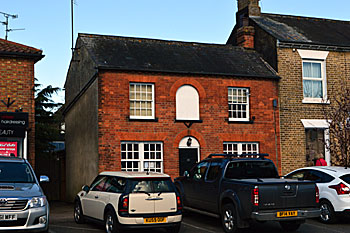28 High Street Toddington

28 High Street March 2016
The property at 28 High Street appears on the Agas Map of 1581. It was listed by the former Department of the Environment in 1980 as Grade II, of special interest. At this time the building was being used as a shop. In the listing the property is described of dating from around the 16th century, remodelled in the 1830s. The L-shaped building is timber-framed, faced in red brick, with the front range of Flemish bond with brick dentil eaves, a rendered gable end and a slate roof. The three-bay 16th century rear wing may originally have been open to the roof and floored in the 17th century. The two-room plan front range was added and rebuilt parallel to the street around the 1830s. The rear wing was extended around the early 19th century and again later in the 19th century. The later 19th century coach house and stable on the left has double doors and a hay-loft door. Inside the rear wing has a late 18th or early 19th century moulded wooden chimney-piece and chamfered cross-beam in the ground floor room, with a tie-beam and wind brace exposed in the chamber above. There is evidence of some smoke-blackening of roof timbers in the rear wing.
The present occupier [2015] has sketched the development of the property over the past 500 years and sketches of the changing south elevation of the property from 1500 to 2000 can be seen in Toddington Through the Ages by David Buckingham. In the first half of the 19th century the property was owned by the Freeman family. In 1852 it was sold to Frederick Burr, a member of a Luton brewing family, for £290 [X95/300]. It was presumably at this time that the house became a beerhouse known as the Greyhound. By 1859 it was occupied by Joseph Brewer, who remained in occupation in 1878 when a conveyance and discharge of mortgage described it as a "dwellinghouse, formerly the Greyhound public house". A bakehouse at the rear of the property was occupied in 1860 by Henry Lines. After it ceased trading as a beerhouse 28 High Street was used by a shoemaker, a hairdresser, and an optician, with a builder and undertaker at the rear. It is now a private house.
The Rating and Valuation Act 1925 specified that every building and piece of land in the country was to be assessed to determine its rateable value. The valuer found 28 High Street owned and occupied by H. J. Cleaver. The brick and slate semi-detached property comprised a shop measuring 19 feet by 12½ feet, two reception rooms and a kitchen downstairs, and four bedrooms upstairs. The condition of the house was very good at the front but poor at the back. Outbuildings comprised a brick and tile coach house, stables and loft, and a timber and slate store. All were in poor condition.
Kelly's Directory for 1928 lists Cleaver Brothers as tobacconists, wholesale and retails confectioners and drug stores. They were still listed in the final directory for the county – 1940.